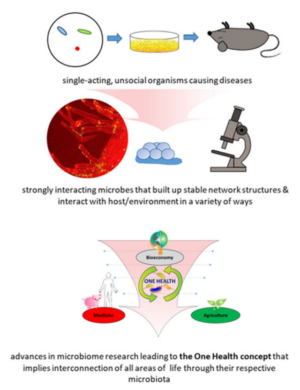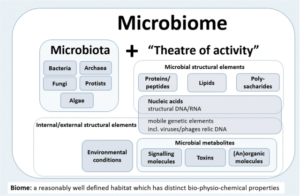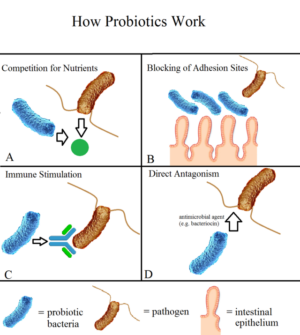The 2021 Biennale in Venice introduced a new concept into architecture: the probiotic design. From the 19th century onwards, architects and housewives tried to keep the interior of our buildings as clean and non-biotic as possible. But recent discoveries have shown that ‘good’ bacteria can stop ‘bad’ ones. And thereby improve the health effect of the building. Some architects now ask themselves: how can we, in the design of our buildings, promote the good ones? A challenging and almost unexplored field.

Health through beneficial microbes
Bacteria can make our buildings healthier. Practitioners of ‘microbial architecture’ or ‘probiotic design’ try to discover how and why. This is a new area of the bioeconomy, combining architecture and microbiology. How can we include healthy bacterial strains in our buildings? In such a way that they remain active, and come into action if ‘bad’ bacteria enter their environment? As said, this is a new field of scientific research. We know that healthy microbiomes can have positive health effects. Couldn’t we then cultivate microbial communities for positive health outcomes? Influence the environment? Can we design a building probiotically with positive health effects, because of the benign bacteria it contains?
Such a view is almost the opposite of the view that surfaced in the nineteenth century. Then, a spirit of cleanliness took hold of mankind. In this view, diseases resulted from bad smells and odours. It led to the adoption of purification of buildings, like by plastering, coating and whitewashing; and of course, to a culture of cleanliness in general. A spirit that has not yet been generally overcome. Architectural thought still clings to the antibiotic turn. But now, a counterflow is gaining strength: the idea that benign microbial life might strengthen human health. A design approach that has got the name NOTBAD: Niches for Organic Territories in Bio-Augmented Design. Resulting in the probiotic design that finds ways to incorporate living communities of beneficial microbes into our buildings and interior designs.

The importance of microbiomes
A microbiome is a microbial community, characteristic for a certain location (for instance, within our guts). The term not only refers to the microorganisms involved, but also encompasses their activity. We find microbiomes across every environment on earth. Tiny but abundant. Macro phenomena like the global phosphorus and nitrogen cycles depend on microbial communities. And also, inside our bodies, microbes perform vital functions that keep us alive.
The concept that microbial communities can have beneficial effects has got hold of our approaches in the use of probiotic yoghurts and other probiotic foods. Here, the microbes produce compounds like vitamins, antioxidants, and enzymes that our bodies need, and often do not produce them on their own. Their effects have by far not been fathomed yet. Microbial architecture bear some resemblance to this. Here we seed buildings and surfaces with carefully selected microbial species.

Probiotic architecture
In probiotic design, we actively encourage beneficial microbes to colonize our buildings. In doing so, we discourage infectious microorganisms to grow. We could view the beneficial microbes as health supplements even though we will not be aware of them. Even out in the open, beneficial microbes might filter the air and clean it from pollutants and pathogens. Even though such a future may still be a long way off.
Beneficial microbes might also be of major importance to hospitals – helping to suppress harmful strains of bacteria. These are becoming a major problem. Antibiotics and antibacterial chemicals have triggered an evolutionary arms race, that could well result in bacterial strains that are no longer vulnerable to our drugs and chemicals. The standard procedure in hospitals is to sterilize instruments and surfaces with powerful chemicals. Wiping out the beneficial species together with the harmful ones. By strengthening the beneficial microbes, we could shape a completely new theatre with healthier environments for our patients.
Richard Beckett, probiotic pioneer
Worldbiomarketinsights.com highlights the achievements of Richard Beckett as a pioneer in this field. He is a probiotic designer based at University College London and researches the question how we could achieve healthy homes using bacteria. His work shows that living bacterial communities can prevent the growth of harmful pathogens by encouraging robust, diverse communities of healthy ones.
But not only did he identify bacteria that have such a beneficial effect, he also developed substrates that will support them. An ideal substrate will support the beneficial bacteria but leave them dormant most of the time. On the other hand, if conditions change to the worse – for instance by the entry of air pollution or a toxic mould – they should begin to multiply fast, in order to counteract the new condition. Beckett found excellent probiotic building materials in ceramic-based hybrid materials. They maximise bacterial survival.
Luffa
A New York based studio called The Living created a pavilion at the 2021 Venice Architecture Biennale. It demonstrated how organic materials with microbial properties can be used in architecture, creating healthier environments for humans. This is part of an ongoing research project. Bio-receptive materials in the pavilion host microorganisms – in surfaces containing pockets with different temperatures, moisture levels, air flow and nutrients. These organic, living materials support colonies of microbes that in turn promote the health of people in their vicinity.
The installation is made from dried fibres of luffa – an inexpensive, renewable and fast-growing vegetable that grows on vines in tropical and subtropical regions. These surfaces form a strong and organic material; ideally suited to hosting diverse microbes. According to The Living, luffa can be easily be adapted into many environments. For instance, to offices and restaurants, where it could be formed into partition walls and acoustic tiled ceilings. Or it could be used for microbial facades to office buildings, removing pathogens from the air.
Understanding indoor microbiomes
Indoor microbiomes will need microbial testing services; in order to analyse microbial communities, present in a building. Worldbiomarketinsights.com mentions CoreBiome, a University of Minnesota spinoff. They sample and analyse microbiomes in any environment, from agricultural cropland to human bodies. The site speculates that with the genomic information that companies like CoreBiome can provide, future startups could one day assess the microbial deficiencies of an indoor space. And then create tailored microbiomes to improve its health profile. But it is still early days. Much more research needs to be done before we can purposely manipulate the probiotic properties of our buildings.
The same holds true for the link between our health and the diversity of beneficial microorganisms. A data base like mBodyMap maps such links. But mostly, the precise effects of interactions between the microbiomes in our bodies and in our environment is still poorly understood. So, we also do not know very well what kinds of building materials and spaces we need to support probiotic organisms. Needless to say, this exciting new research area is in fast development.
Interesting? Then also read:
Psychology of innovation: biotechnology should learn to listen!
The microbial food revolution
Who are we? The microbiome revisited
